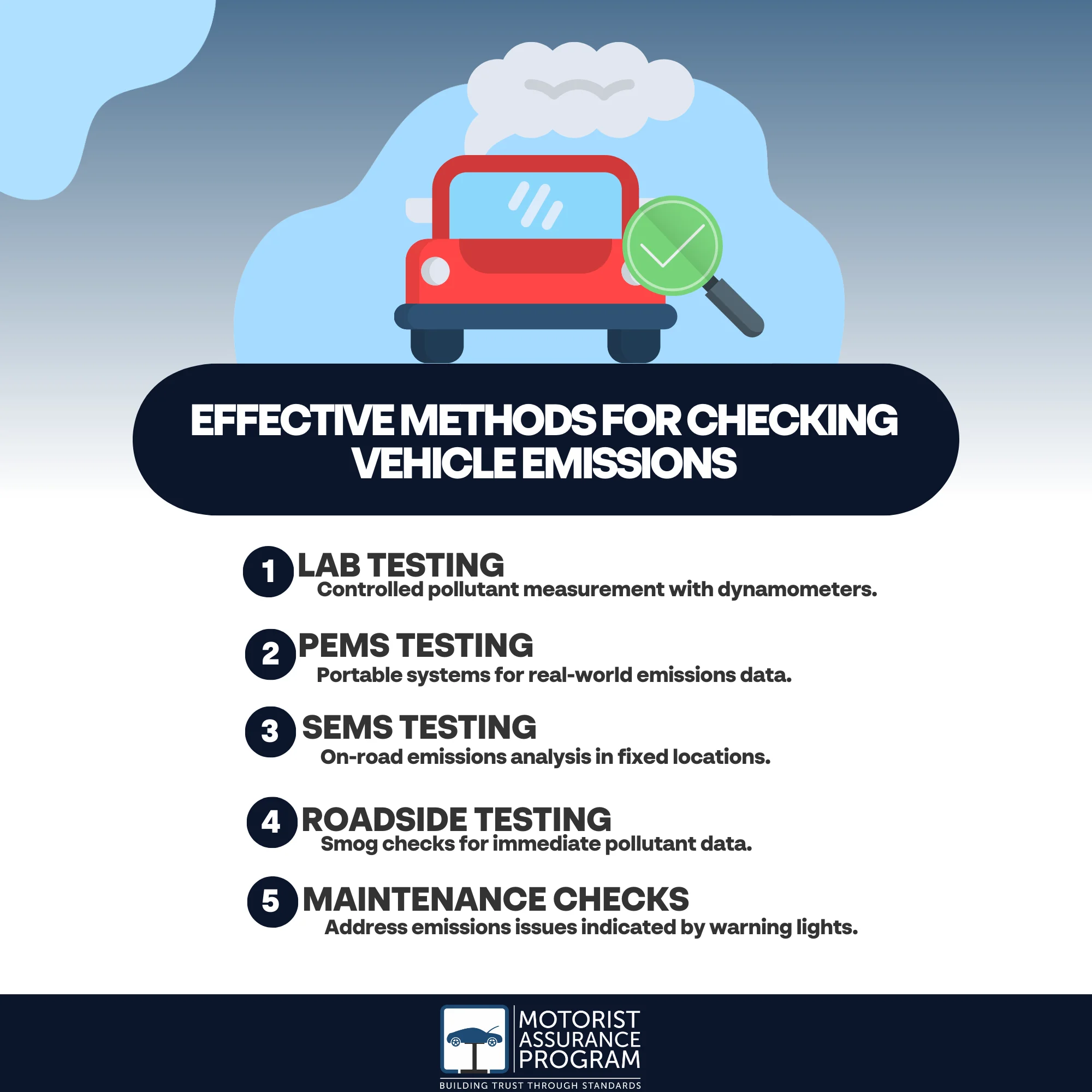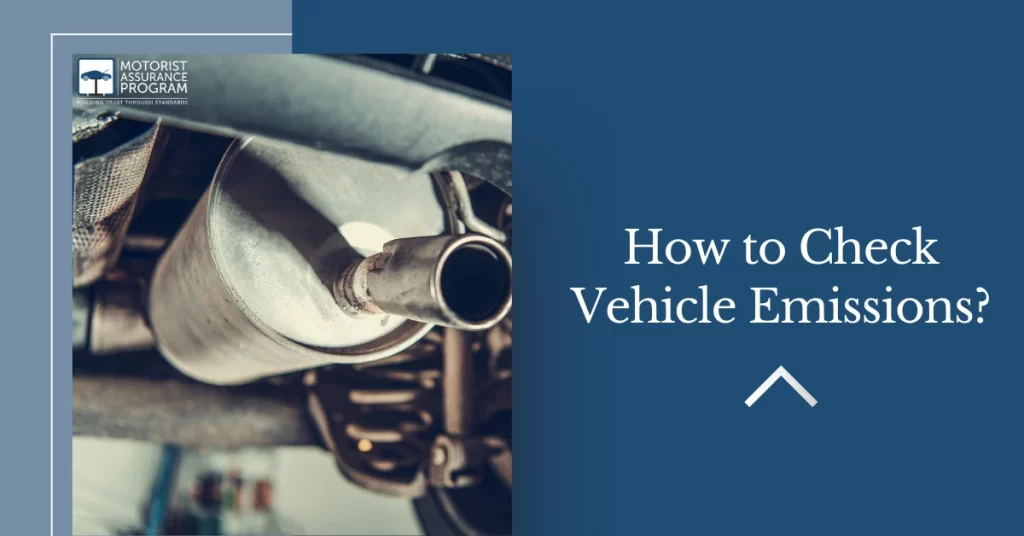To check your vehicle’s emissions, you can conduct a laboratory test, employing a dynamometer to simulate road conditions and measure pollutant concentrations. More accurately, you might use an on-road Portable Emission Measurement System (PEMS) or Smart Emission Measurement System (SEMS) that captures real-world emissions data under various driving conditions. Alternatively, you can perform a roadside test, using a smog check device to detect carbon monoxide, nitrogen oxides, and hydrocarbons. Checking the ‘check engine’ light can also indicate any triggered emissions codes, hinting towards a potential issue. Diving deeper into each method will provide an all-encompassing view of emission checking strategies.

Key Takeaways
- Vehicle emissions can be checked using laboratory testing, which measures specific pollutant concentrations under simulated road conditions.
- On-road testing with Portable Emissions Measurement Systems (PEMS) provides real-world emissions data while driving.
- On-road testing with Stationary Emissions Measurement Systems (SEMS) offers real-time emissions analysis in a fixed location.
- Roadside testing involves using a smog check device to measure pollutants expelled into the atmosphere.
- A triggered check engine light may indicate an emissions code has been set off, signaling potential issues with vehicle emissions.
Laboratory testing
When it comes to checking vehicle emissions, laboratory testing plays an essential role. It provides a controlled environment where precise measurements of pollutants can be recorded. You might be wondering how to check emissions status. The process begins by placing the vehicle on a dynamometer, simulating road conditions while the vehicle remains stationary.
In this scenario, an emissions vehicle check can be performed across varying speeds, acceleration rates, and temperatures. An analyzer connected to the exhaust pipe measures the concentrations of specific pollutants, such as hydrocarbons, nitrogen oxides, and carbon monoxide. This data helps in determining the check vehicle emissions status, indicating whether a vehicle meets the regulatory standards.
However, laboratory testing isn’t infallible. It can sometimes fail to accurately represent real-world driving conditions, leading to discrepancies in emission results.
Further, it’s essential to highlight that though it provides a thorough understanding of a vehicle’s emissions, laboratory testing isn’t the only method used. Nonetheless, it remains a significant part of the emission inspection process, forming the foundation for further testing methodologies.
On-road testing with PEMS
Often, on-road testing with Portable Emission Measurement Systems (PEMS) complements laboratory testing for a thorough emission evaluation.
When you want to check vehicle emissions, PEMS provides real-world, accurate results, unlike stationary lab tests.
PEMS, a high-tech tool, measures the exhaust emissions of a car while it’s being driven on the road.
PEMS is capable of capturing transient operating conditions that lab tests might miss.
So, how to check vehicle emissions using PEMS? The process is rather straightforward, but it requires technical expertise.
PEMS equipment is attached to the vehicle, and the vehicle is driven on a pre-determined route.
The system then records the exhaust emissions under various driving conditions.
On-road testing with SEMS
Shifting gears from PEMS, we now explore the technique of on-road testing with Stationary Emission Measurement Systems (SEMS). This method differs markedly from PEMS as the vehicle emissions check is conducted in a fixed location.
SEMS are set up in an area where a vehicle can drive through and have its emissions measured in real time. It’s a method that allows you to check if your vehicle needs emissions testing without the need for an appointment or a garage visit. The system uses advanced technology such as remote sensing devices (RSD) to measure the pollutants emitted by the vehicle’s exhaust as it passes through the SEMS.
Here’s how to check your vehicle emissions with SEMS. First, locate a SEMS set up in your area. Next, drive your vehicle through the SEMS at the prescribed speed. The system will then analyze the exhaust plume that your vehicle emits. The results of the test are often available immediately and can be obtained online or through a mobile app.
Keep in mind that SEMS provide a snapshot of your vehicle’s emissions performance under specific driving conditions. As a result, regular checks are essential to ascertain consistent compliance with emission standards.
Roadside testing
Diving headfirst into roadside testing, you’ll find it’s another effective method for checking vehicle emissions. This evaluation provides essential data on the amount of pollutants your car expels into the atmosphere.
To perform the clean air car check vehicle emissions, you’ll need a smog check device. This tool measures the concentration of various pollutants in your car’s exhaust. It’s particularly keen on detecting the presence of carbon monoxide, nitrogen oxides, and hydrocarbons – all harmful substances that contravene environmental regulations.
You might wonder how to check emissions on your car. Well, it’s not as intimidating as it may seem. When the check engine light flashes, it’s usually due to an emissions code. This code is triggered when your car’s system detects an anomaly in the emission control system.
However, keep in mind that a lit check engine light emissions code doesn’t always signify a failed emissions test. Other factors, like a loose gas cap, can also activate this light. Therefore, it’s essential to get a professional diagnosis to ascertain the real issue.
Roadside testing isn’t a mere obligation. It’s a significant step towards cleaner, healthier air.
Frequently Asked Questions
What Are the Common Signs of Excessive Vehicle Emissions?
You’ll notice excessive vehicle emissions through signs like a decrease in gas mileage, rough idling, engine misfires, or a smell of fuel. Your check engine light may also come on if emissions are too high.
Why Is Regular Vehicle Emissions Testing Important?
Regular emissions testing’s as essential as your yearly check-up. It guarantees you’re not excessively polluting the environment, keeps your car running efficiently, and prevents future costly repairs. It’s all about preserving health – yours and Earth’s.
How Does My Vehicles Emission Impact the Environment?
Your vehicle’s emissions impact the environment by releasing greenhouse gases, contributing to climate change. They also release pollutants that harm air quality, potentially causing health issues for you and others in your community.
What Are the Penalties for Failing an Emissions Test?
If you fail an emissions test, you’ll face penalties. These can include fines, license suspension, or being unable to renew your registration. The severity of penalties varies by state, so check your local laws.
Can Routine Maintenance Help Reduce My Vehicles Emissions?
Yes, routine maintenance can help reduce your vehicle’s emissions. Regular oil changes, tune-ups, and timely replacement of air and fuel filters can optimize your vehicle’s performance and minimize its environmental impact.
Conclusion
You’ve become a green warrior, checking your vehicle emissions like a pro. Remember, even a 10% reduction in harmful emissions from your car can equate to thousands of pounds less carbon dioxide in the atmosphere annually. That’s a significant step towards a cleaner, healthier planet. So, keep up the rigorous testing and meticulous maintenance. Every time you turn your key, remember – you’re not just driving, you’re making a difference.


